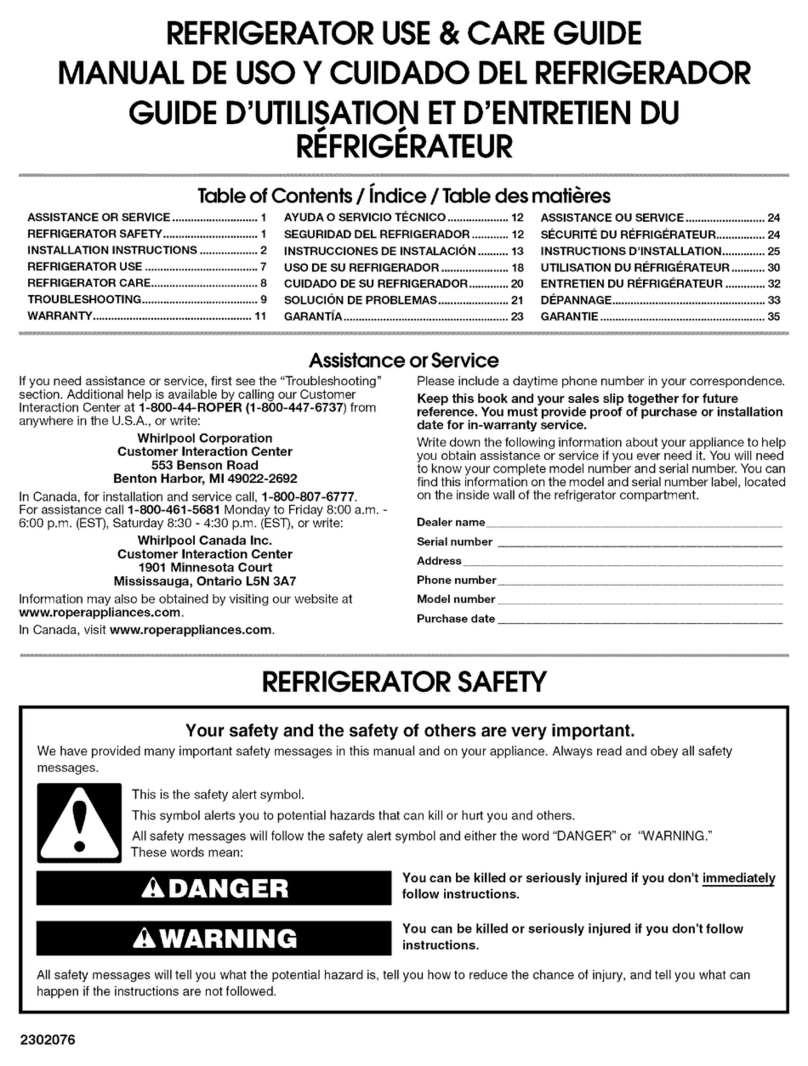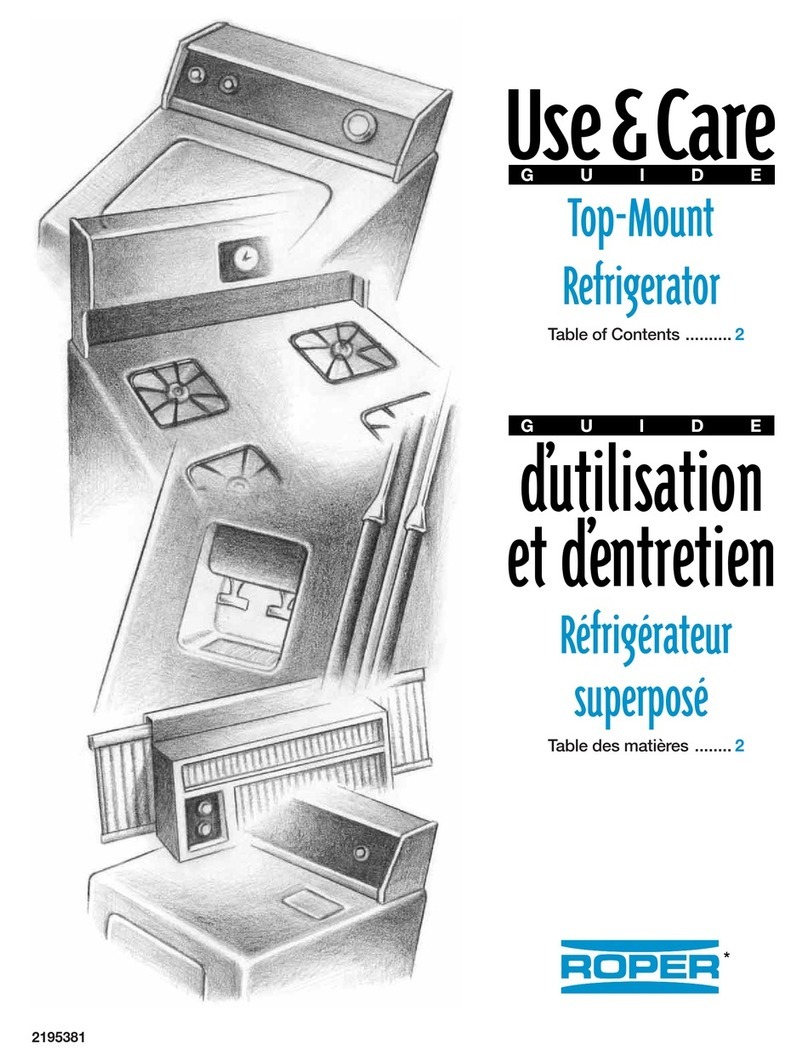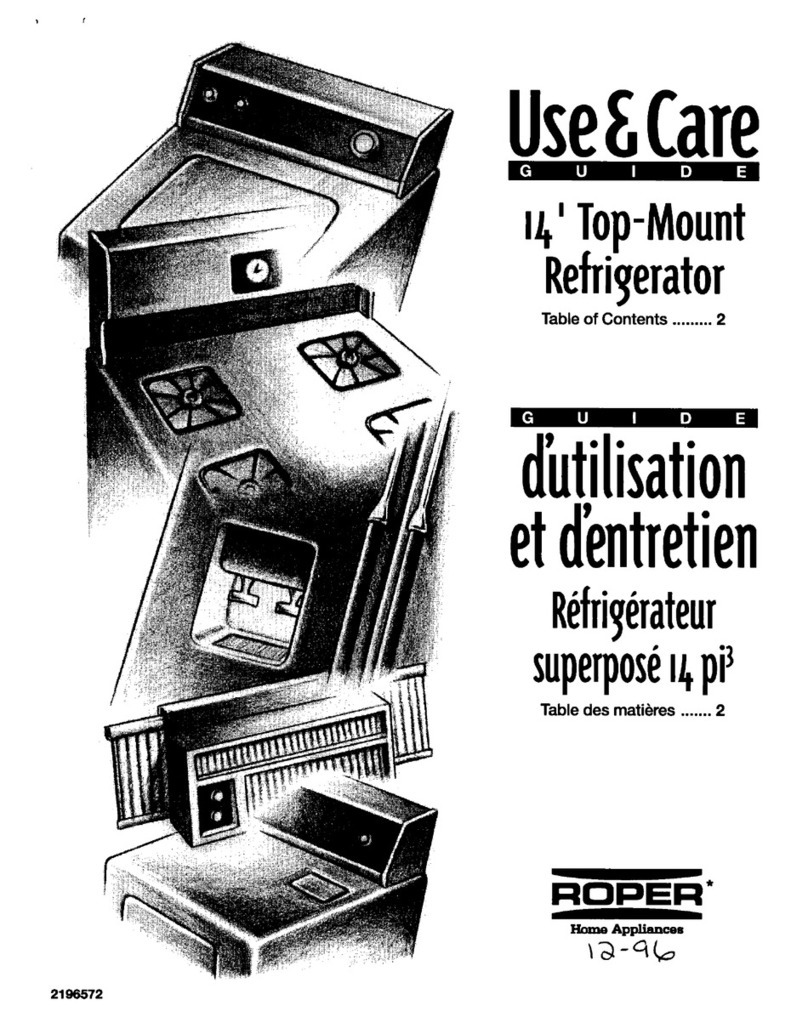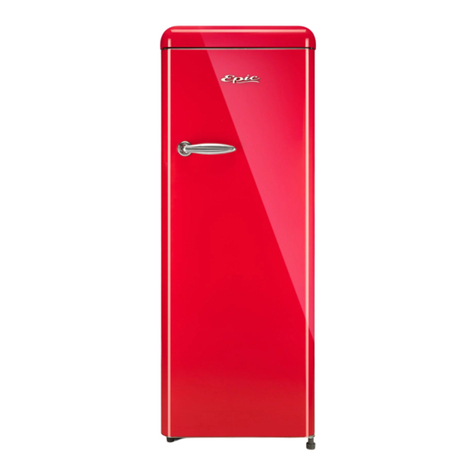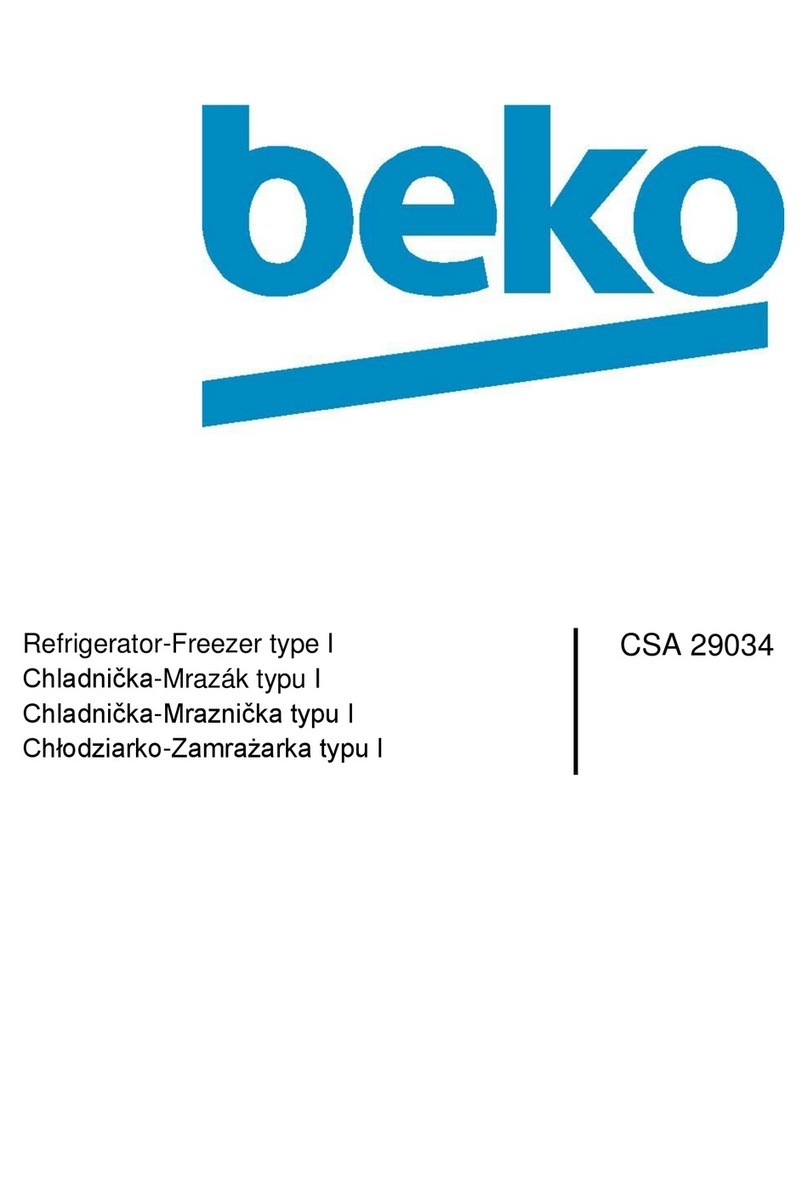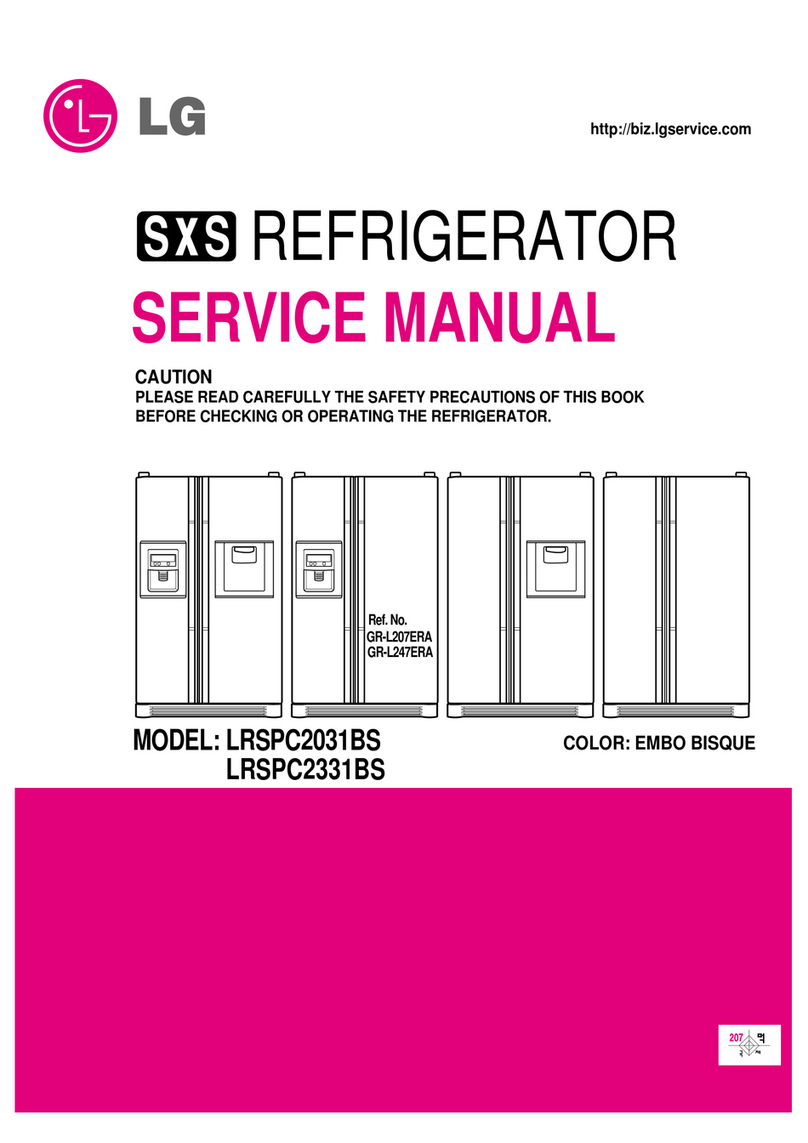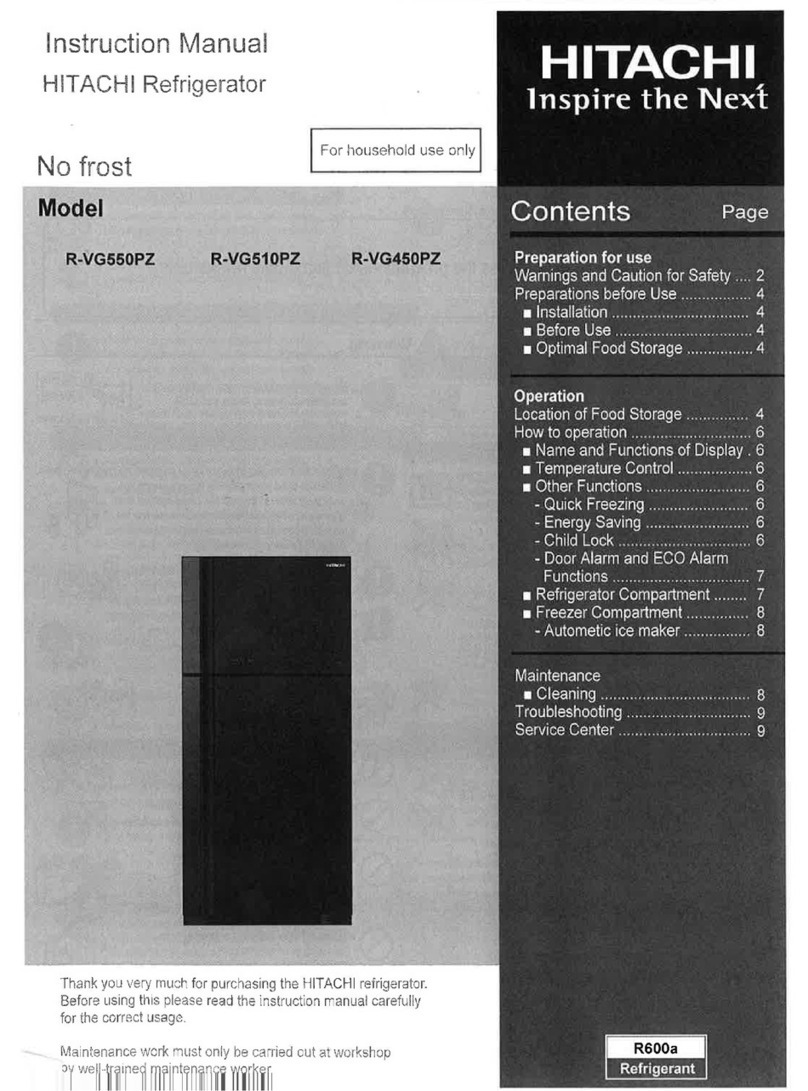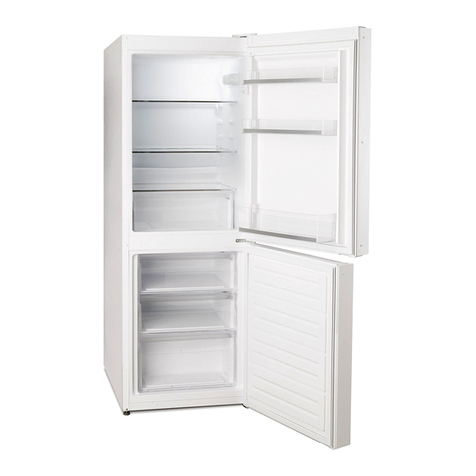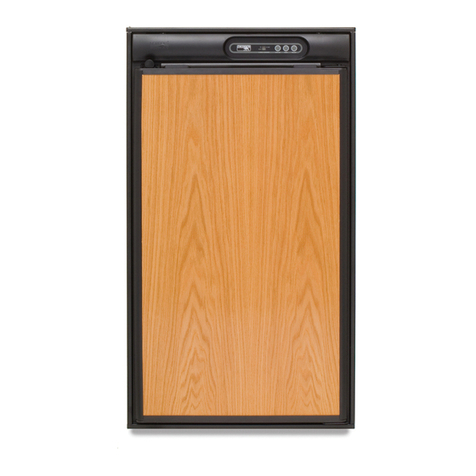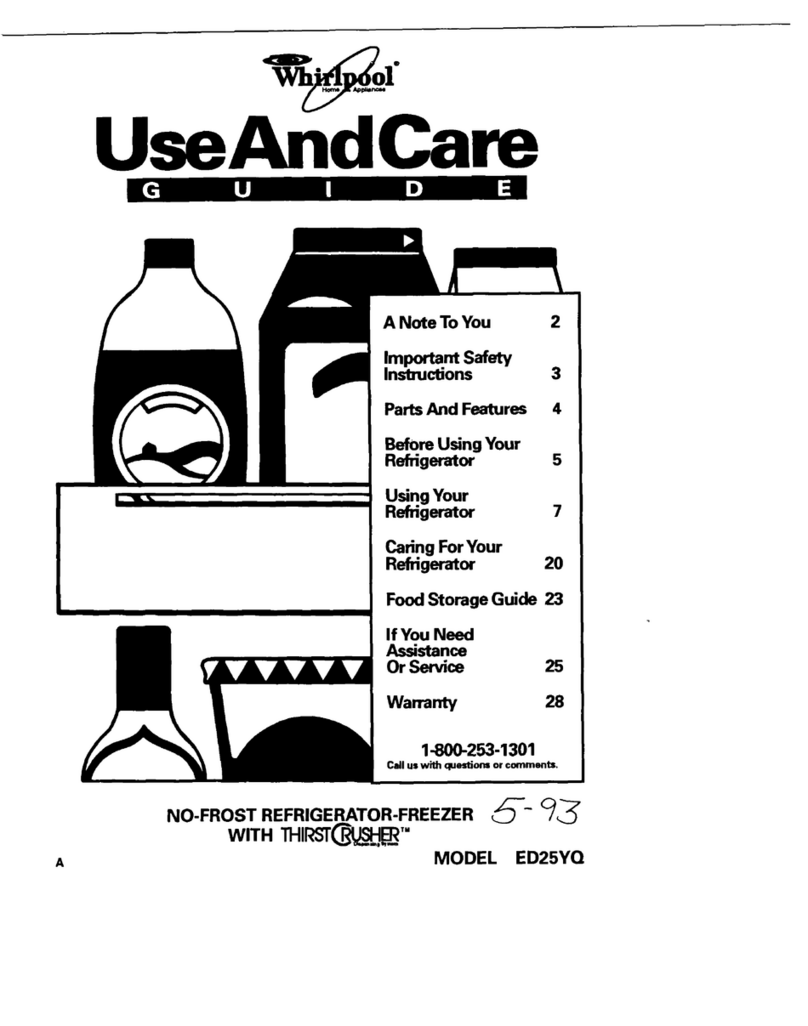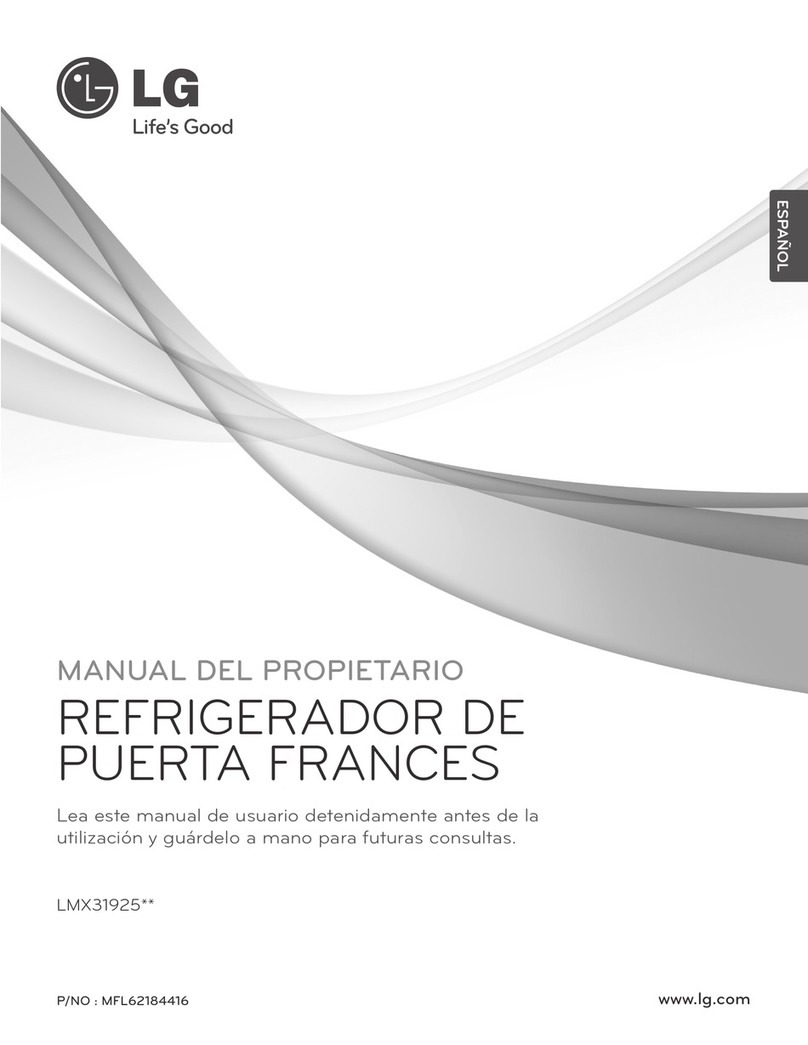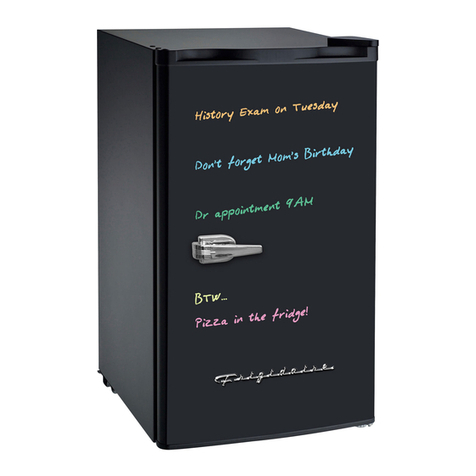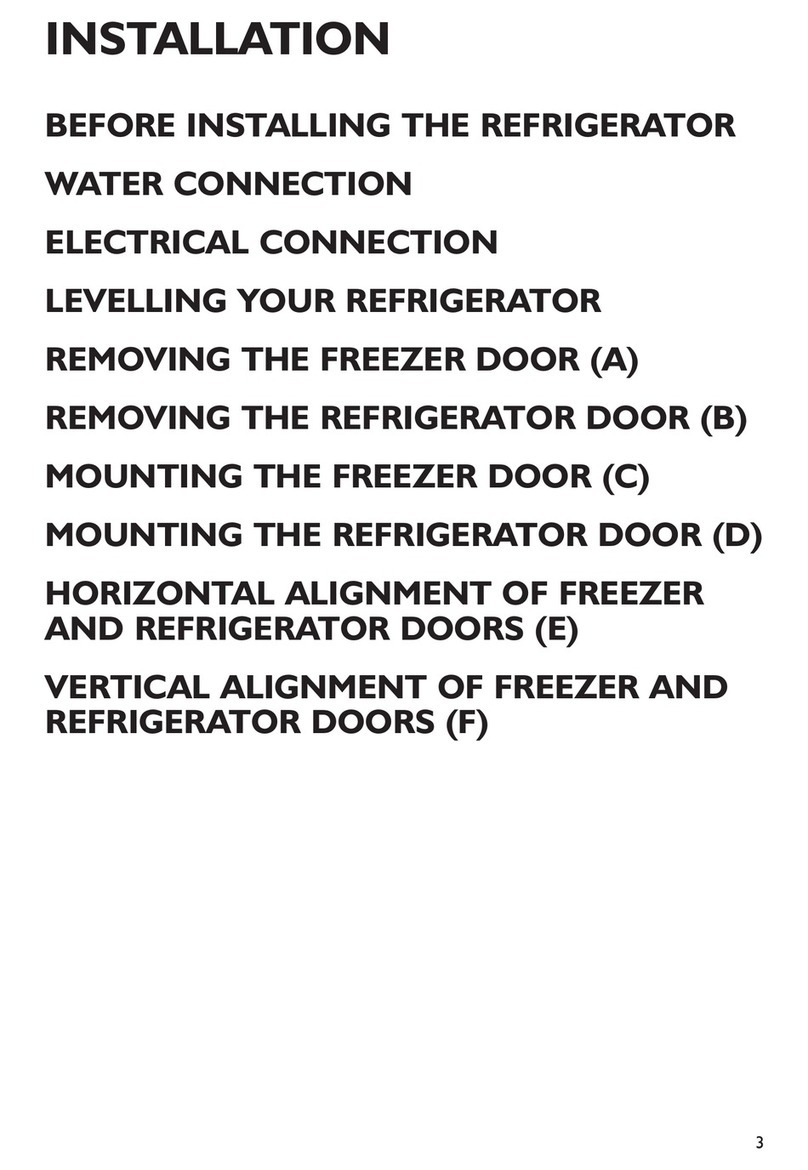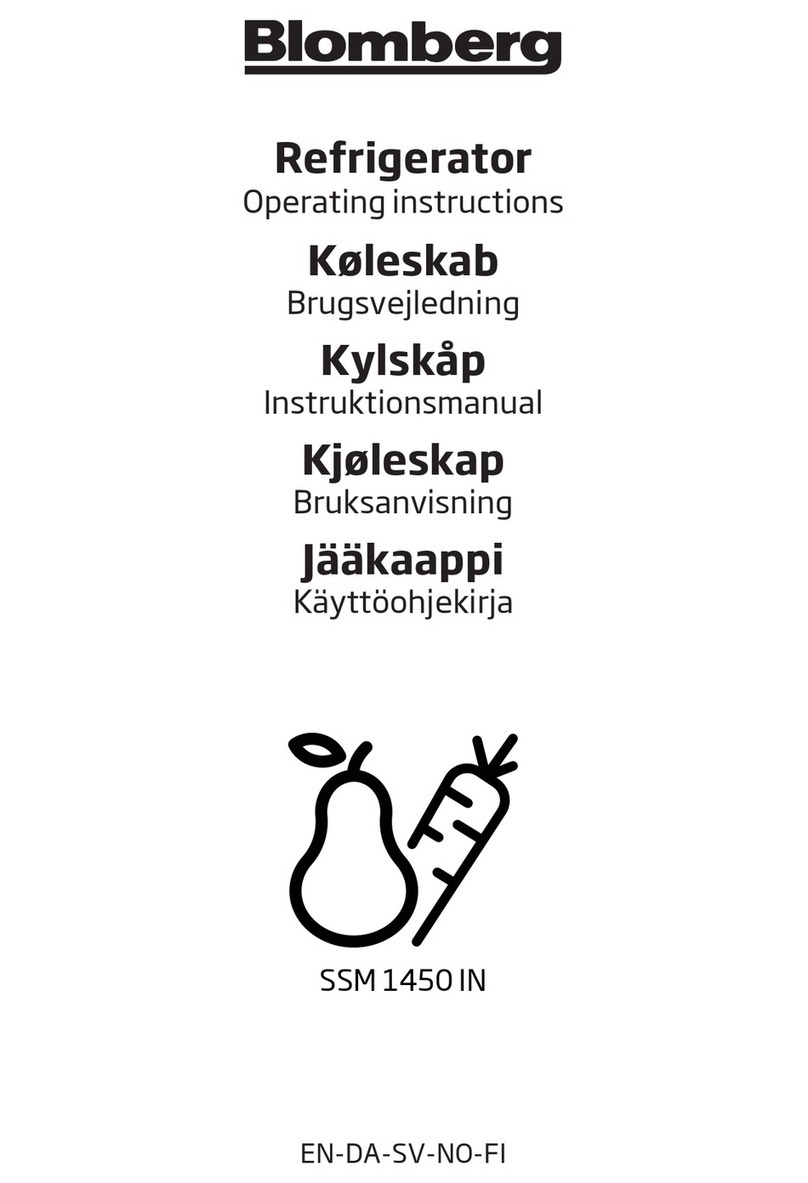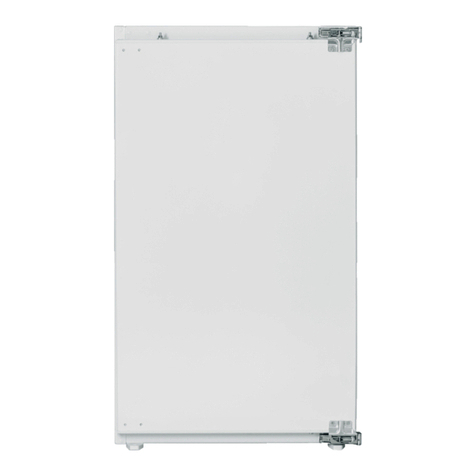Roper RS25AW User manual

UseAndCare
ee
A Note To You 2
ktZEZZl:dm 3
Parts And Features 4
Before Using Your
Refrigerator 5
Using Your
Refrigerator 7
cikrtl;~our 17
Food Storage Guide 19
If You Need
Assistance
Or Service 22
Warranty 24
I-BOO-44-ROPER
Cdl us with questions of comments.
L J
u-sa
NO-FROST REFRIGERATOR-FREEZER
MODEL RS25AW

A Note To You
Thank you for buying a Roper appliance.
You have purchased a quality, world-class home appliance. Years of engineering experience have gone
into its manufacturing. To ensure that you will enjoy many years of trouble-free operation, we have
developed this Use and Care Guide. It is full of valuable information on how to operate and maintain
your appliance properly and safely. Please read it carefully. Also, please complete and mail the Owner-
ship Registration Card provided with your appliance. This will help us notify you about any new informa-
tion on your appliance.
Your safety is important to us.
This guide contains safety symbols and statements. Please pay special attention to these symbols and
follow any instructions given. Here is a brief explanation of the use of each symbol.
This symbol will help alert you to such dangers as
personal injury, burns, fire and electrical shock. This symbol will help you avoid actions which
could cause product damage (scratches, dents,
etc.) and damage to your personal property.
Our toll-free number, l-800-44-ROPER (l-800-447-67371, is
available 24 hours a day.
If you ever have a question concerning your appliance’s operation, or if you need service, first see “If
You Need Assistance Or Service” on page 22. If you need further help, feel free to call us. When calling,
you will need to know your appliance’s complete model number and serial number. You can find this
information on the model and serial number label (see diagram on page 4). For your convenience, we
have included a handy place below for you to record these numbers, the purchase date from the sales
slip and your dealer’s name and telephone number. Keep this book and the sales slip together in a safe
place for future reference.
Model Number
Serial Number
Purchase Date
Dealer Name
Dealer Phone
2

Immrtant Safetv Instructions
To reduce the risk of fire, electrical shock, or injury when using your
refrigerator, follow these basic precautions:
l
Read all instructions before using the
refrigerator.
l
Child entrapment and suffocation are not
problems of the past. Junked or abandoned
refrigerators are still dangerous ... even if
they will “just sit in the garage a few days.”
If you are getting rid of your old refrigerator,
do it safely. Please read the enclosed safety
booklet from the Association of Home
Appliance Manufacturers. Help prevent
accidents.
l
Never allow children to operate, play with, or
crawl inside the refrigerator.
l
Never clean refrigerator parts with flammable
fluids. The fumes can create a fire hazard or
explosion.
l
FOR YOUR SAFETY
l
DO NOT STORE OR USE GASOLINE OR
OTHER FLAMMABLE VAPORS AND LIQUIDS
IN THE VICINITY OF THIS OR ANY OTHER
APPLIANCE. THE FUMES CAN CREATE A
FIRE HAZARD OR EXPLOSION.
I
- SAVE THESE INSTRUCTIONS -
Help us help you
Please:
l
Install and level the refrigerator on a floor that
will hold the weight and in an area suitable for
its size and use.
l
Do not install the refrigerator near an oven,
radiator or other heat source.
l
Do not use the refrigerator in an area where the
room temperature will fall below 55°F (13°C).
l
Keep the refrigerator out of the weather.
l
Connect the refrigerator only to the proper kind
of outlet, with the correct electrical supply and
grounding. (Refer to the Electrical Require-
ments and Grounding Instructions Sheet.)
l
Do not load the refrigerator with food before it
has time to get properly cold.
l
Use the refrigerator only for the uses described
in this manual.
l
Properly maintain the refrigerator.
l
Be sure the refrigerator is not used by anyone
unable to operate it properly.
Also, remove tape and any inside labels (except
the model and serial number label) before using
the refrigerator.
To remove any remaining glue:
l
Rub briskly with thumb to make a ball, then
remove.
OR
l
Soak area with liquid hand dishwashing
detergent before removing glue as described
above. Do not use sharp instruments, rubbing
alcohol, flammable fluids or abrasive cleaners.
These can damage the material. See “lmpor-
tant Safety Instructions” above.
NOTE: Do not remove any permanent instruction
labels inside your refrigerator. Do not remove the
Tech Sheet fastened under the refrigerator at the
front.
3

PartsAnd Features
This section contains captioned illustrations of your appliance. Use them to become familiar with where
all parts and features are located and what they look like.
Control panel light
Automatic
ice maker -
Ice bin .
tight \
Uttlity
compartment
Model and
serial
number label
(on 8ide wall)
Adjust
nemovame
freszw ahelv~
Meat drawer
Control panel
-qj- ,q- -m--o
Freezer control
Refrigerator control
4

Before Using Your
Refrigerator
In This Section Pap PW
Cleaning it ...........................................................5 Installing it properly ........................................5
Plugging it in .......................................................5 Leveling it .........................................................6
It is important to prepare your refrigerator for use. This section will tell you how to clean it, connect ii to
a power source, install it and level it.
Cleaning it
Clean your refrigerator before using it, if neces-
sary. See cleaning instructions on page 17.
Plugging it in
Recommended Grounding Method
A 115 Volt, 60 Hz., AC only 15 or 20 ampere
fused and properly grounded electrical supply is
required. It is recommended that a separate
circuit serving only this appliance be provided.
Use a receptacle which cannot be turned off with
a switch or pull chain. Do not use an extension
cord.
See Electrical Requirements and Grounding
Instructions Sheet in your Literature Package.
&prong grounding
type wall receptacle
Refrigerator
power cord
grounding plug
Installing it properly
1. Allow ‘A inch (1.25 cm) space on each side
and at the top of the refrigerator for ease of
installation.
2. If the refrigerator is to be against a wall, you
might want to leave extra space on the hinge
side closest to the wall so the door can be
opened wider.
3. The refrigerator can be flush against the wall.
5

Leveling it
Your refrigerator has 2 front leveling screws-one
on the right and one on the left. To adjust one or
both of these, follow the directions below.
1. Remove base grille. (See page 14.)
2. To raise front, turn screw clockwise.
3. To lower front, turn screw counterclockwise.
4. Check with level.
5. Replace base grille. (See page 14.)
Front
r0llw
Riaht to raise:
Ill
idt t0 ~WH
Use
a
screwdriiw
II0 to adid
6

Using Your Refrigerator
In This Section
Pa*
Setting the controls ........................................... .7
Changing the control settings ........................... 6
Adjusting the refrigerator shelves ................... .6
Removing the crisper and crisper cover.. ....... .9
Removing the
meat drawer
and cover.. ........... -9
Adjusting the meat drawer temperature.. ........ .9
Removing the tree-r shelves ......................... 10
Removing the trsezer basket.. ......................... 10
Using
the automatic ice maker.. ......................
11
Pa*
Removing the ice maker storage bin ...........12
Using the cold water
and
ice
dispensers ..................................
.............. 13
Solving common ice maker/dispenser
problems ......................................................... 14
Removing the base grille .............................. 14
Changing the light bulbs ............................... 15
Understanding the sound6 you may hear ... 16
Saving energy ................................................ 16
In order to obtain the best possible results from your refrigerator, it is important that you operate it
properly. This section will tell you how to do just that.
Setting the controls
Controls for the refrigerator and freezer are in the
refrigerator. When the refrigerator is plugged in for
the first time:
1. Set the Refrigerator Control to 3.
Refrigerator Control adjustments range from
1 (warmest) to 5 (coldest).
2. Set the Freezer Control to B.
Freezer Control adjustments range from
A (warmest) to C (coldest).
3. Give the refrigerator time to cool down com-
pletely before adding food. This may take
several hours.
The settings indicated above should be
correct for normal, household refrigerator
usage. The controls will be set correctly when
milk or juice is as cold as you like and when ice
cream is firm. If you need to adjust these
settings, see “Changing the control settings” on
page
a.
NOTE: The Automatic Exterior Moisture control
continuously guards against moisture build-up on
the outside of your refrigerator cabinet. This
control does not have to be set or adjusted.
I -ToR
Em
z
4
1
CD
CID
a-
m
A
C
WIllA
0
CID-
7

Changing the control settings
If you need to adjust temperatures in refrigerator
or freezer, use the settings listed in the chart
below as a guide. If you have questions, call us.
(See page
23.)
l
Adjust the Refrigerator Control first.
l
Wait at least 24 hours between adjustments.
l
Then adjust the Freezer Control if needed.
I
RECOMMENDED
CONDITION: REASON: CONTROL SElTINGS:
If Refrigerator
Section is
TOO WARM
If Freezer
Section is
TOO WARM
If Refrigerator
Section is
TOO COLD
Door opened often
Large amount of food added
Room temperature too warm
Door opened often
Large amount of food added
Very cold room temperature
(can’t cycle often enough)
Controls not set correctly
for your conditions
Refrigerator
Freezer :
Refrigerator
Freezer E
Refrigerator 2
Freezer B
If ICE isn’t
MADE FAST
ENOUGH
If BOTH
SECTIONS
are TOO WARM
Heavy ice usage
Very cold room temperature
(can’t cycle often enough)
Door opened often
Large amount of food added
Very warm or very cold room
temperatures
Refrigerator
Freezer :
Refrigerator 4
Freezer B
Adjusting the refrigerator shelves
Shelves can be adjusted to match the way you
use your refrigerator. Glass shelves are strong
enough to hold bottles, milk and other heavy food
items.
To remove shelves:
Glass shehres are
heavy. Handle
them with care.
1. Remove items from shelf.
2. Tilt shelf up at front.
3. Lift sheff up at back.
4. Pull shelf straight out.
To replace shelves:
1. Guide the rear hooks into the slots in the shelf
supports.
2. Tilt up front of shelf until hooks drop into slots.
3. Lower front of shelf to level position.
a

Removing the crisper and crisper cover
To remove the crisper:
1. Slide the crisper straight out to the stop.
2. Lift the front.
3. Slide out the rest of the way.
4. Replace in reverse order.
To remove the cover:
1. Tilt front of cover up.
2. Lift cover up at back
3. Pull cover straight out.
To replete the cover:
1. Fit back of cover into notched supports on
walls of cabinet.
2. Lower front of cover into place.
ull out to the stop,
lift ths front
nd pull again.
Removing the meat drawer and cover
To remove the meat drawer:
1. Slide the meat drawer out to the stop. i
2. Lift the front.
3. Slide meat drawer out the rest of the way.
4. Replace in reverse order.
To remove the cover:
1. Remove crisper, crisper cover and meat
drawer.
2. Tilt front of cover up, lift at back and pull
straight out.
3. Replace in reverse order.
Adjusting the meat drawer temperature
Cold air flows against the meat drawer through
an opening between the freezer and the refrig-
erator. This helps keep the meat drawer colder
than the rest of the refrigerator for better storage
of meats.
Slide the control to let more or less cold air
through.
9

Removing the freezer shelves
The freezer shelves can be removed for easier
cleaning.
To remove the shelves:
1. Lift right side of shelf off supports.
2. Slide shelf out of shelf support holes.
3. Replace in reverse order.
Removing the freezer basket
For proper air movement, keep the freezer
basket in place when the refrigerator is operating.
To remove the basket:
1. Slide basket out to the stop.
2. Lift basket at the front to clear the stop.
3. Slide basket out the rest of the way.
To replace the basket:
1. Place basket on the slides.
2. Make sure the stops clear the front of the
slides.
3. Slide basket in.
10

Using the automatic ice maker
Here are a few things you will want to know about
your automatic ice maker:
l
The ON/OFF lever is a wire signal arm.
Down ... to make ice automatically.
up ... to shut off the ice maker. . . .
NOTE: Do not turn .
connected to the vdmwklmtructlons for
are atw
&shed to the back of the ~QWEWQC
cabinet.
l
Shake the bin occasionally to keep cubes
separated and to obtain increased storage
capacity.
l
It is normal for ice crescents to be attached by
a corner. They will break apart easily.
l
You will hear water running when ice maker is
working. You’ll hear ice fall into the bin. Don’t
let these sounds bother you.
l
The ice maker will not operate until the freezer
is cold enough to make ice. This can take
overnight.
l
Because of new plumbing connections, the first
ice may be discolored or off-flavored. Discard
the first few batches of ice.
l
If ice is not being made fast enough and more
ice is needed, turn the Refrigerator Control
toward a higher number. Wait a day and, if
necessary, turn the Freezer Control toward C.
l
If you remove the ice bin, raise the signal arm
to shut off the ice maker. When you return the
bin, push it in all the way and lower the signal
arm to the ON position.
l
If cubes are stored too long, they may develop
an off-flavor ... like stale water. Throw them
away. Ice maker will make new ice. Cubes in
the ice bin can also become smaller by
evaporation.
l
Good water quality is important for good ice
quality. It is not recommended that the ice
maker be connected to a softened water
supply. Water softener chemicals, such as salt
from a malfunctioning softener, can damage the
ice maker mold and lead to poor ice quality. If a
softened water supply cannot be avoided, it is
important that the water softener be well
maintained and operating property.
Raise
signal
arm to
stop ice
maker.
Lower
signal
arm to
start ice
maker.
11

Removing the ice maker storage bin
Remove, empty and clean the storage bin if:
l
the ice dispenser has not, or will not, be used
for a week or more.
l
a power failure causes ice in the bin to melt and
freeze together.
l
the ice dispenser is not used regularly.
To remove ice bin:
1. Pull the covering panel out from the bottom
and slide it to the rear.
2. Lift the signal arm so it clicks into the OFF (up)
position. Ice can still be dispensed, but no
more can be made.
3. Lift the front of the storage bin and pull it out.
4. Empty the ice bin. Use hot or warm water to
mett the ice if necessary. Never use anything
sharp to break up ice in the bin. This can
damage the bin and dispenser mechanism.
5. Wash with mild detergent. Rinse well. Do not
use harsh or abrasive cleaners or solvents.
6. When replacing the bin, make sure it is
pushed in all the way. Then push the signal
arm down to the ON position to restart ice
production.
12

Using the cold water and ice dispensers
Personal Injury Hazard
Tumbling ice and pressure on a fragile glass
can break it. Do not use a fragile glass
when dispensing ice.
Doing so could result in personal injury or
breakage.
The ice dispenser
Ice is dispensed from the ice maker storage bin in
the freezer. When the dispenser bar is pressed, a
trapdoor opens in a chute between the dispenser
and the ice bin. Ice is moved from the bin and falls
through the chute. When the dispenser bar is
released, a buzzing sound may be heard for a few
seconds as the trapdoor closes.
The dispensing system will not operate when
the freezer door is open.
NOTE: Large amounts of ice should be taken
from the ice bin, not through the dispenser.
To dispense ice:
1. Press a sturdy glass against the ice dispenser
bar. Hold glass close to the dispenser opening
so ice does not fall outside of glass.
2. Remove the glass to stop dispensing.
NOTE: The first few batches of ice may have an
off taste from new plumbing and parts. Throw the
ice away.
The water dispenser
Chilled water comes from a tank behind the meat
drawer. It holds approximately
1%
quarts
(1.5
L).
When the refrigerator is first hooked up, press
the water dispenser bar with a glass or jar until
you have drawn and discarded 2 or 3 quarts (1.9
to 2.9 L). The water you draw and discard will
rinse the tank and pipes.
Allow several hours to chill a new tankful.
NOTE: The small tray beneath the dispenser is
designed to evaporate small spills. There is no
drain in this tray. Do not pour water into it.
To dispense water:
1. Press a sturdy glass against the water
dispenser bar.
2. Remove the glass to stop dispensing.
NOTE: Dispense enough water every week to
maintain a fresh supply.
13

Solving common ice maker/dispenser
problems
PROBLEM CAUSE SOLUTIONS
Ice dispenser
won’t work
l
Freezer door open
l
Ice bin not properly
installed
l
Wrong ice in bin
l
Dispenser not used for
extended periods,
causing ice cubes to
melt together
l
Close the freezer door.
l
Make sure bin is pushed in all the way.
l
Use only crescents from ice meker.
Shake the bin occasionally to keep cubes
separated and to obtain increased storage
capacity.
l
Dump old ice and make a new supply.
Ice dispenser stops
l
Ice dispenser bar held
l
Wait about 3 minutes for the dispenser
working in too long motor to reset.
l
Large amounts of ice should be taken
from the bin, not through the dispenser.
Off-taste or odor
in ice
l
Ice attracts airborne
odors; old ice
l
Water quality
l
Foods not properly
wrapped
l
Ice bin and freezer may
need cleaning
l
Plumbing to ice maker
l
New ice maker
l
Dump old ice and make a new supply.
Store excess ice in covered container.
l
Water containing minerals (such as sulfur)
may require a filter to remove.
l
Wrap properly. See pages 20 and 21.
. Clean freezer and ice bin. See cleaning
chart on page 18.
l
Follow Installation Instructions for proper
ice maker water supply hook up. (See
back of refrigerator cabinet.)
l
The first few loads of ice from a new ice
maker may have an off-taste. Dump ice
and make a new supply.
Removing the base grille
To remove the grille:
1. Open both doors.
2. Pull base grille forward to release the support
tabs from the metal clips.
3. Do not remove Tech Sheet fastened behind
the grille.
To replace the grille:
1. Line up grille support tabs with metal clips.
2. Push firmly to snap into place.
3. Close the doors.
See cleaning instructions for defrost pan and
condenser coils on page 18.
14
Condenser coils

Changing the light bulbs
Electrical Shock Hazard
Before removing a light bulb, either unplug
the refrigerator or disconnect the electricity
, leading to lt at the main power supply.
Failure to do so could result in personal
1 injury.
To change refrigerator light:
1. Disconnect refrigerator from power supply.
2. Reach behind the Control Console to remove
bulb.
3. Replace bulb with a 40-watt appliance bulb.
4. Reconnect refrigerator to power supply.
To change crisper light:
1. Disconnect refrigerator from power supply.
2. Pull top of light shield forward until it snaps
free.
3. Lower light shield to clear bottom supports.
4. Pull light shield straight out to remove.
5. Replace bulb with a 40-watt appliance bulb.
6. Replace light shield in reverse order.
7. Reconnect refrigerator to power supply.
To change lower freezer light:
1. Disconnect refrigerator from power supply.
2. Grasp front of light shield.
3. Pull bottom of light shield forward until it snaps
free.
4. Replace with a 40-watt appliance bulb.
5. Press light shield straight on until it snaps into
place.
6. Reconnect refrigerator to power supply.
To change upper freezer light:
1. Disconnect refrigerator from power supply.
2. Lift top of light shield up and pull shield out.
3. Replace bulb with a 40-watt appliance bulb.
4. Place light shield over bulb and snap shield
into place.
5. Reconnect refrigerator to power supply.
NOTE: Not all commercial appliance bulbs will fit
your refrigerator. Be sure to replace bulb with one
of the same size and shape.
, I
cnJa rn
.
I
CrisDer
li’ght
Lower
freezer
- light
UPPM
freezer
- light
15

Understanding the sounds you may hear
Your new refrigerator may make sounds that your
old one didn’t. Because the sounds are new to
Water sounds
you, you might be concerned about them. Don’t
be. Most of the new sounds are normal. Hard
surfaces like the floor, walls and cabinets can
make the sounds seem louder.
The following describes the kinds of sounds
You may hear the refrigerator’s fan motor and
moving air.
Clicking or snapping sounds
that might be new to you, and what may be
making them.
Slight hum, soft hiss
When the refrigerator stops running, you may
hear gurgling in the tubing for a few minutes after
it stops. You may also hear defrost water running
into the defrost water pan.
trickling water and the clatter of ice dumped into
the bin.
Running sounds
Ice maker sounds
l
trickling water
l
thud (clatter of ice)
You may hear buzzing (from the water vafve),
The thermostat makes a definite click when the
refrigerator stops running. It also makes a sound
when the refrigerator starts. The defrost timer will
click when the defrost cycle starts.
Your refrigerator has a high-efficiency compres-
sor and motor. It will run longer than older
designs. It may even seem to run most of the
time.
Saving energy
You can help your refrigerator use less electricity.
l
Check door gaskets for a tight seal. Level the
cabinet to be sure of a good seal.
l
Clean the condenser coils regularly.
l
Open the door as few times as possible. Think
about what you need before you open the door.
Get everything out at one time. Keep food
organized so you won’t have to search for what
you want. Close door as soon as food is
removed.
l
Go ahead and fill up the refrigerator, but don’t
overcrowd it so air movement is blocked.
l
It is a waste of electricity to set the refrigerator
and freezer to temperatures colder than they
need to be. If ice cream is firm in the freezer
and drinks are as cold as your family likes
them, that’s cold enough.
l
Make sure your refrigerator is not next to a heat
source such as a range, water heater, furnace,
radiator or in direct sunlight.
16

Caring For Your Reiiigemtor
In This Section Pam Page
Ckming your rdrigwdor ............................... 17 Power
interruptions .......................................
19
Vacation and moving care ............................... 18
Your refrigerator is built to give you many years of dependable service. However, there are a few things
you can do to help extend its product life. This section will tell you how to clean your refrigerator and
what to do when going on vacation, moving or during a power outage.
Clei wing your refrigerator
Both the refrigerator aid freezer sections defrost
automatically. But both should be cleaned about
once a month to help prevent odors from building
UD. SDills should be wiDed
UD
riaht away. Personal Injury Hazard
’ To’clean your refrigerator: t&r the Refrigerator Refrigeration system tubes are located near
Control to OFF, unplug it, take out all removable the defrost pan and can become hot. Remove
parts and clean the refrigerator according to the and install defrost pan carefully.
following directions. Failure to do so could resuft in personal injury.
PART WHAT TO USE HOW TO CLEAN
Removable parts Sponge or cloth with mild
l
Hand wash, rinse and dry thoroughly.
(shelves, crisper, etc.) detergent and warm water
Outside Sponge, cloth or paper towel
l
Wash outside of cabinet. Do not use
with mild detergent, warm abrasive or harsh cleaners.
water and an appliance wax
(or good auto paste wax)
l
Rinse and dry thoroughly.
l
Wax painted metal surfaces at least
twice a year. Apply wax with a clean,
soft cloth. Waxing painted metal
surfaces provider rust protection.
Do not wax plastic parts.
Inside walls
(freezer should be Sponge, soft cloth or paper
l
Wash with mixture of warm water and
towel with baking soda or - mild detergent, or
allowed to warm up mild detergent and warm
so cloth won’t stick) - baking soda (2 tablespoons [26 g]
water to 1 quart [.95 L] of water).
l
Rinse and dry thoroughly.
Door liners and Sponge, soft cloth or paper
l
Wash, rinse and dry thoroughly.
gaskets towel with mild detergent
and warm water DO NOT USE cleaning waxes,
concentrated detergents, bleaches or
cleaners containing petroleum on
plastic parts.
Plastic parts
(covers and panels) Soft, clean sponge or soft,
clean cloth with mild
detergent and warm water
l
Wash, rinse and dry thoroughly.
DO NOT USE paper towels, window
sprays, scouring cleansers or
flammable fluids. These can scratch
or damage material. See “Important
Safety Instructions” on page 3.
continued on next page , 7

PART
Defrost pan
WHAT TO USE
Sponge or cloth with
mild detergent and
warm water
HOW TO CLEAN
l
Remove base grille. (See page 14.)
l
To remove defrost pan, lift pan over wire brace
(remove tape: if any).
l
Wash, rinse and dry thoroughly.
l
Replace with notched comer to the rear. Push it
in all the way.
l
Make sure defrost pan drain tube is pointing
into pan.
l
Replace base grille.
Condenser coils
Floor under
refrigerator
Vacuum cleaner with
extended narrow
attachment
Floor cleaners
l
Remove base grille.
l
Vacuum coils when dusty or dirty. Coils may
need to be cleaned as often as every other
month.
l
Replace base grille.
l
Roll refrigerator out away from the wall.
l
Clean floor.
l
Roll refrigerator back into place.
l
Check to see if the refrigerator is level.
Vacation and moving care
Long vacations
Remove all the food if you are going for a month
or more. Turn off the water supply to the ice
maker at least one day ahead. When the last
load of ice drops, turn off the ice maker. Make
sure all ice is dispensed out of mechanism.
Unplug the refrigerator. Clean it, rinse well and
dry. Tape rubber or wood blocks to the tops of
both doors to prop them open far enough for air
to get in. This will keep odor and mold from
building up.
Personal Injury Hazard
Do not allow children to climb on, play near
or climb
---l
inside the refrigerator when the
doors are blocked open.
They may become injured or trapped.
To restart refrigerator, see “Using Your Refrigera-
tor” on page 7.
Short vacations
No need to shut off the refrigerator if you will be
away for less than four weeks. Use up perish-
ables: freeze other items. If you have an auto-
matic ice maker:
1. Turn off your ice maker by raising signal arm.
2. Shut off the water supply to the ice maker.
3. Empty the ice bin.
Moving
Shut off the ice maker water supply at least a day
ahead. Disconnect the water line. After the last
load of ice drops, lift the signal arm to turn off the
ice maker.
Remove all food. Pack frozen food in dry ice.
Unplug the refrigerator and clean it thoroughly.
Take out all removable parts. Wrap all parts
well and tape them together so they don’t shift
and rattle. Screw in the leveling legs; tape the
doors shut; and tape the electric cord to the
cabinet.
When you get to your new home, put every-
thing back and refer to page 5. Also, remember to
reconnect the water supply line.
18

Power interruptions
If electricity goes off, call the power company.
Ask how long power will be off.
1.
If service is to be interrupted 24 hours or less,
keep both doors closed. This will help foods
stay frozen.
2. lf service is to be interrupted longer than
24 hours:
(a) Remove all frozen food and store in a
frozen food locker.
OR
3. A full freezer will stay cold longer than a partly
filled one. A freezer full of meat will stay cold
longer than a freezer full of baked goods. If
food contains ice crystals, it may be safely
refrozen, although the quality and flavor may
be affected. If the condition of the food is poor
or if you feel it is unsafe, dispose of it.
(b) Place 2 Ibs. (0.9 kg) of dry ice in freezer for
every cubic foot of freezer space. This will
keep food frozen for 2 to 4 days. Wear
gloves to protect your hands from dry ice
burns.
OR
(c) If neither a food locker or dry ice is avail-
able, use or can perishable food at once.
Food Storage Guide
In This Section Paw Page
Storing
frwh food ............................................ 19 Storing frozen food ...............v........................20
There is a correct way to package and store refrigerated or frozen food. To keep food fresher, longer,
take the time to study these recommended steps.
Storing fresh food
Food placed in the refrigerator should be
wrapped or stored in air and moisture proof
material. This prevents food odor and taste
transfer throughout the refrigerator. For dated
products, check code date to ensure freshness.
Leafy vegetables
Remove store wrapping and trim or tear off
bruised and discolored areas. Wash in cold water
and drain. Place in plastic bag or plastic con-
tainer and store in crisper.
Vegetables with skins
(carrots, peppers)
Store in crisper, plastic bags or plastic container.
Fruit
Wash, let dry and store in refrigerator in plastic
bags or crisper. Do not wash or hull berries until
they are ready to use. Sort and keep berries in
their store container in a crisper, or store in a
loosely closed paper bag on a refrigerator shelf.
Eggs
Store without washing in the original carton on
interior shelf.
Milk
Wipe milk cartons. For best storage, place milk
on interior shelf.
19

Butter or margarine
Keep opened butter in covered dish or closed
compartment. When storing an extra supply,
wrap in freezer packaging and freeze.
Cheese
Store in the original wrapping until you are ready
to use it. Once opened, rewrap tightly in plastic
wrap or aluminum foil.
Leftovers
Cover leftovers with plastic wrap or aluminum foil.
Plastic containers with tight lids can also be used.
Meat
Most meat can be stored in original wrapping as
long as it is air and moisture proof. Rewrap if
necessary. See the following chart for storage
times.
TYPE
Chicken
APPROXIMATE TIME
(DAYS)
1 to2
Iats 1 to2 I
‘If meat is to be stored longer than the times
given, follow the directions for freezing.
NOTE: Fresh fish and shellfish should be used
the same day as purchased.
Storing frozen food
The freezer section is designed for storage of
commercially frozen food and for freezing food at
home.
NOTE: For further information about preparing
food for freezing or about food storage times,
contact your local Cooperative Extension Service
or check a freezer guide or a reliable cookbook.
Packaging
The secret of successful freezing is in the
packaging. The way you close and seal the
package must not allow air or moisture in or out.
Packaging done in any other way could cause
food odor and taste transfer throughout the
refrigerator and drying of frozen food.
Rigid polyethylene (plastic) containers with
tight fitting lids, straight-sided canning/freezing
jars, heavy-duty aluminum foil, plastic-coated
paper and nonpermeable plastic wraps (made
from a Saran film) are recommended. Follow
package or container instructions for proper
freezing methods.
Packaging recommended for use:
l
Rigid plastic containers with tight-fitting lids
l
Straight-sided canning/freezing jars
l
Heavy-duty aluminum foil
l
Plastic-coated paper
l
Non-permeable plastic wraps (made from a
Saran film)
Follow package or container instructions for
proper freezing methods.
Do not use:
l
Bread wrappers
l
Non-polyethylene plastic containers
l
Containers without tight lids
l
Waxed paper
l
Waxed-coated freezer wrap
l
Thin, semi-permeable wrap
The use of these wrappings could cause food
odor, taste transfer and drying of frozen food.
Freezing
Do not expect your freezer to quick-freeze any
large quantity of food. Put no more unfrozen food
into the freezer than will freeze within 24 hours.
(No more than 2 to 3 pounds of food per cubic
foot of freezer space.) Leave enough space for
air to circulate around packages. Be careful to
leave enough room at the front so the door can
close tightly.
20
Table of contents
Other Roper Refrigerator manuals

Roper
Roper RS20AK User manual
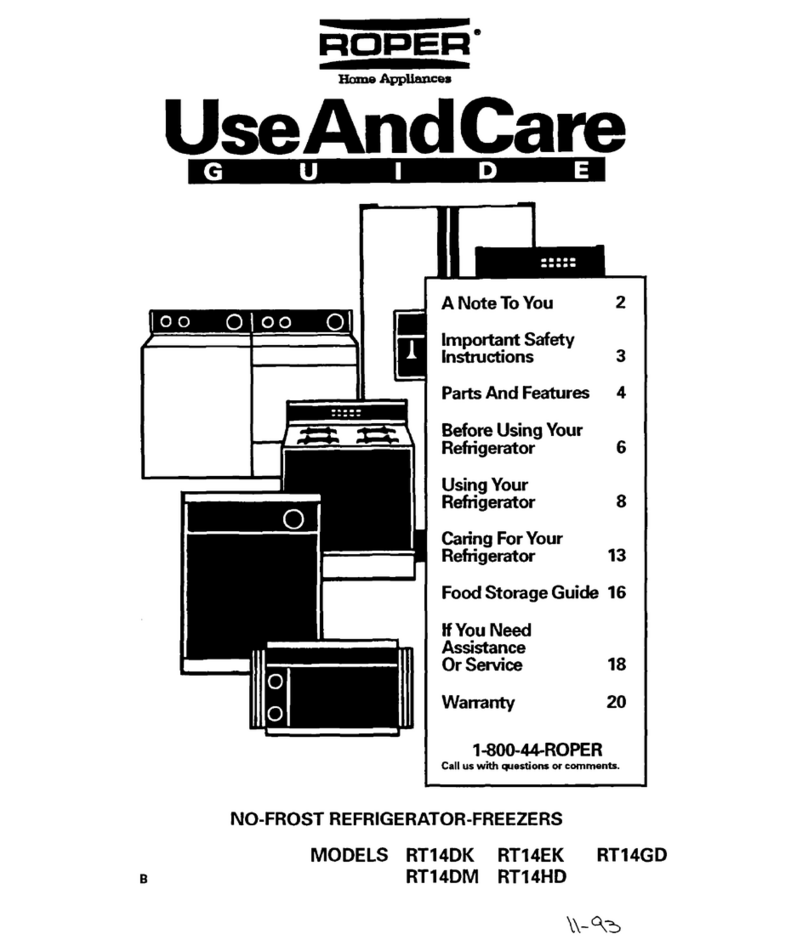
Roper
Roper RT14EK User manual

Roper
Roper RBZICK User manual
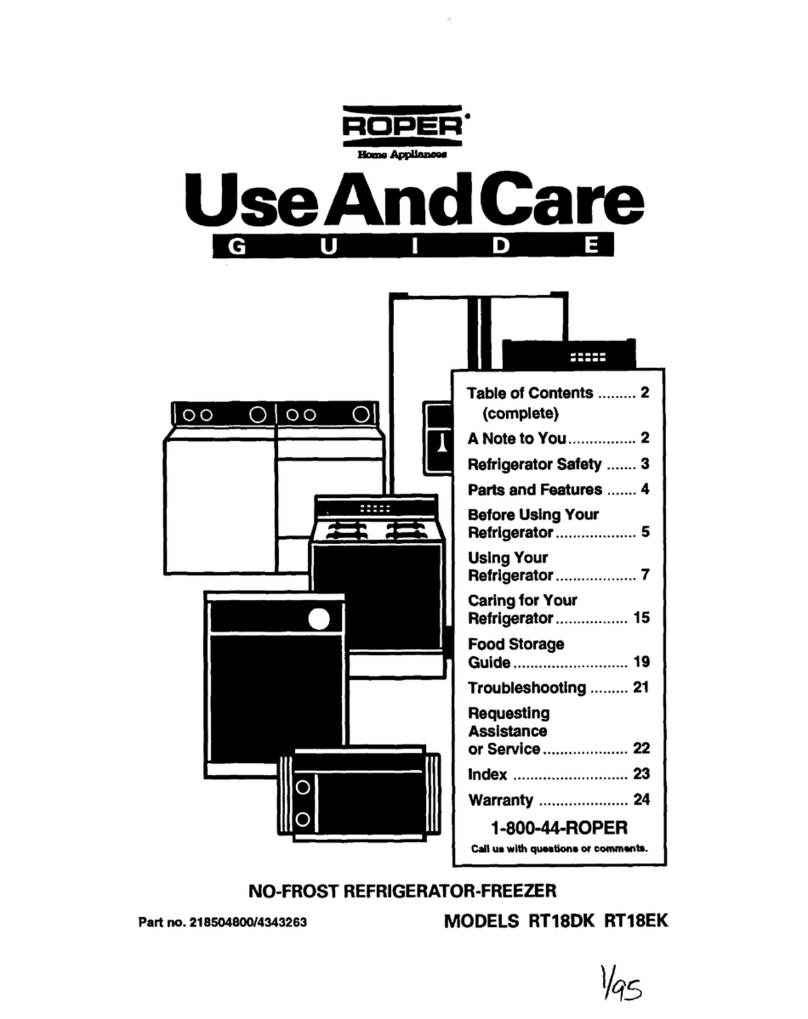
Roper
Roper RT18DK User manual
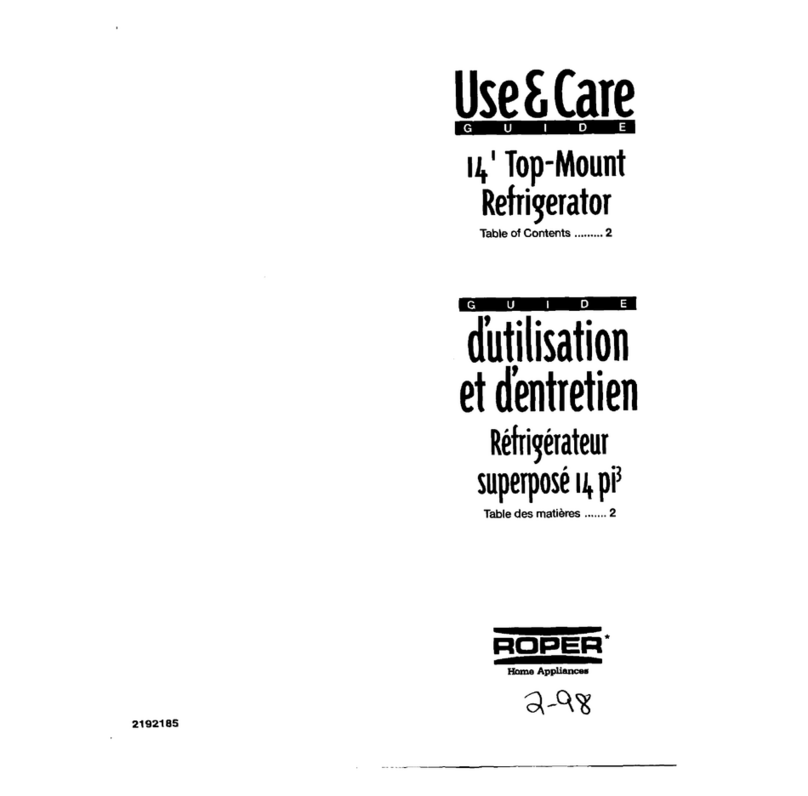
Roper
Roper Roper RT14BKXFN02 User manual

Roper
Roper YRT18VKXJW00 User manual

Roper
Roper RT18HD User manual
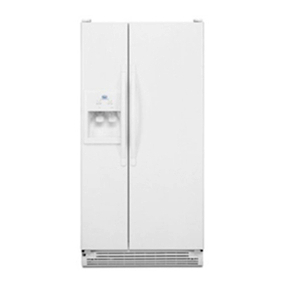
Roper
Roper RS22AQXMQ00 User manual
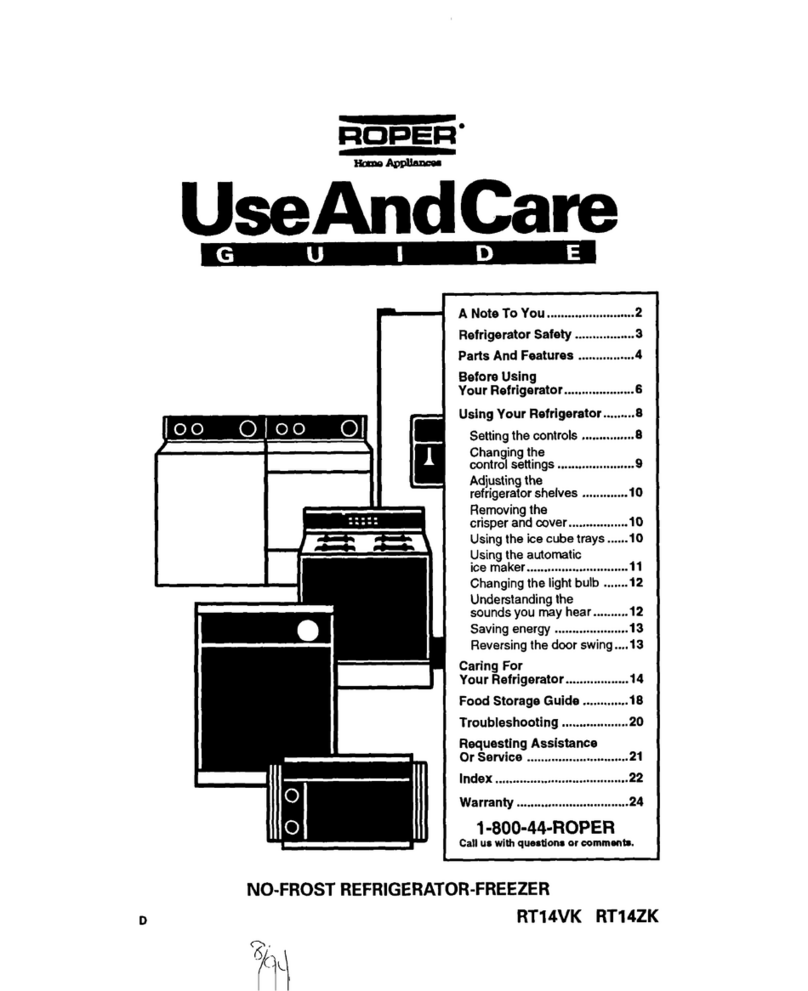
Roper
Roper RT14ZK User manual
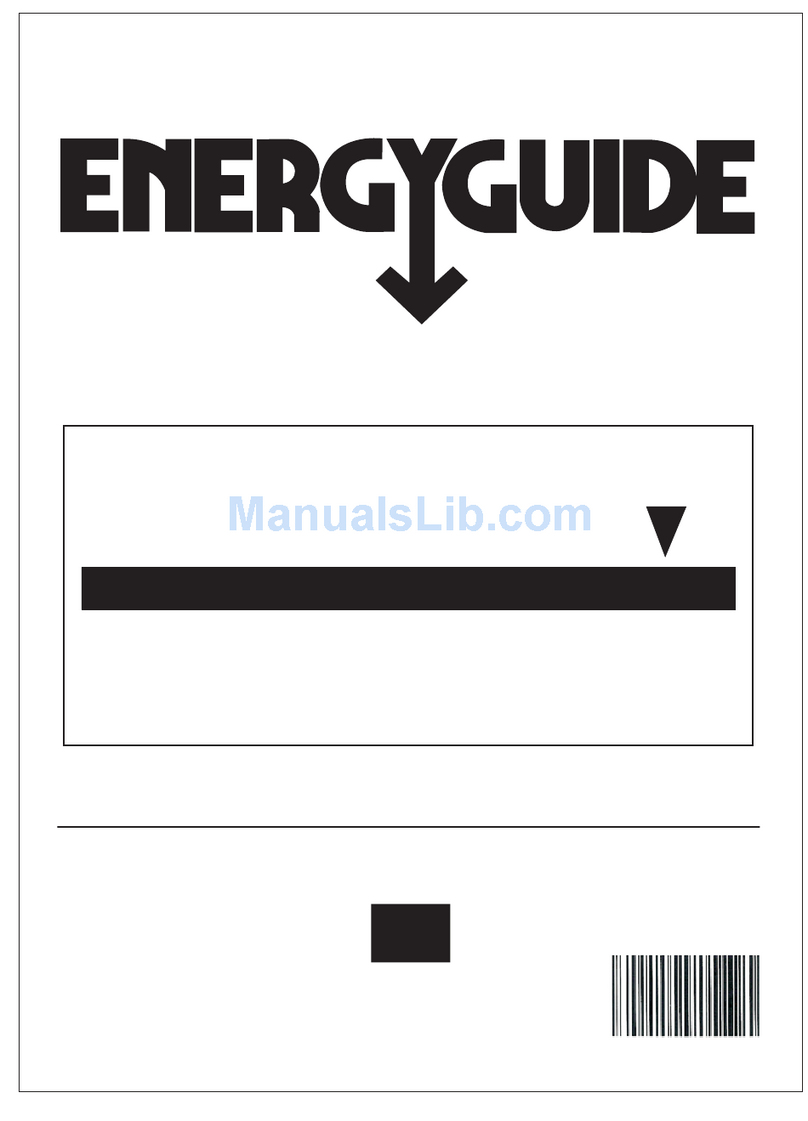
Roper
Roper RT18VKXSQ Assembly instructions

Roper
Roper RT12VKXKQ02 User manual
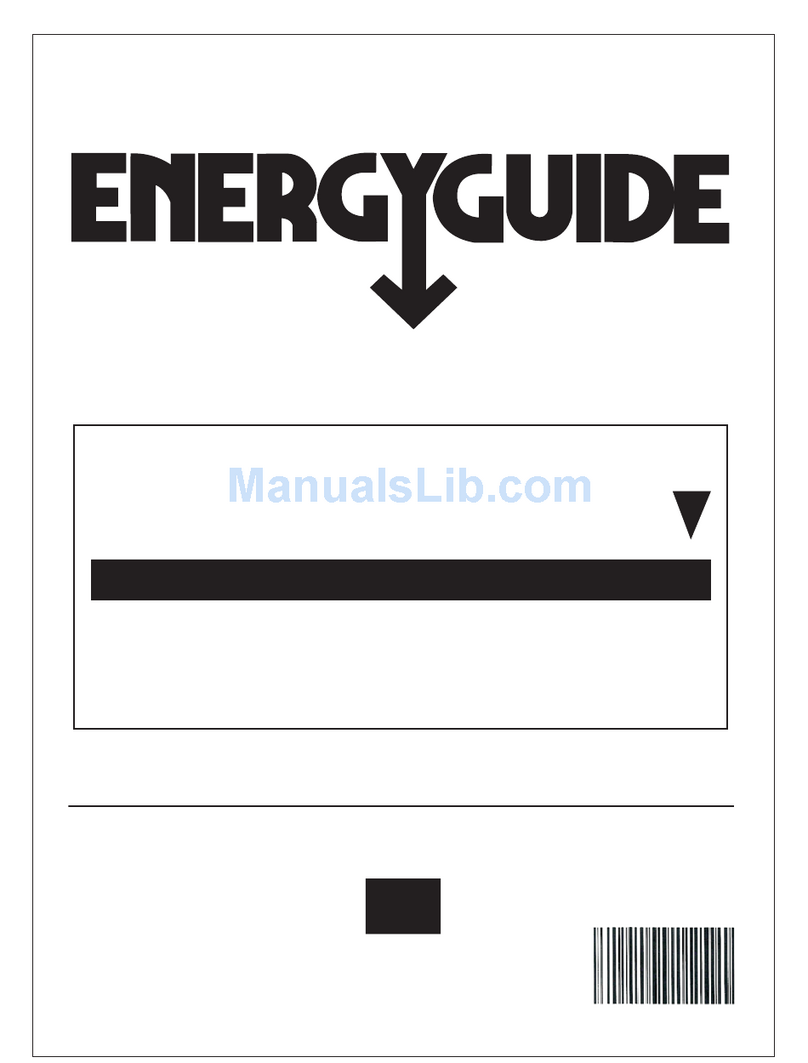
Roper
Roper RT14BKXSQ Assembly instructions
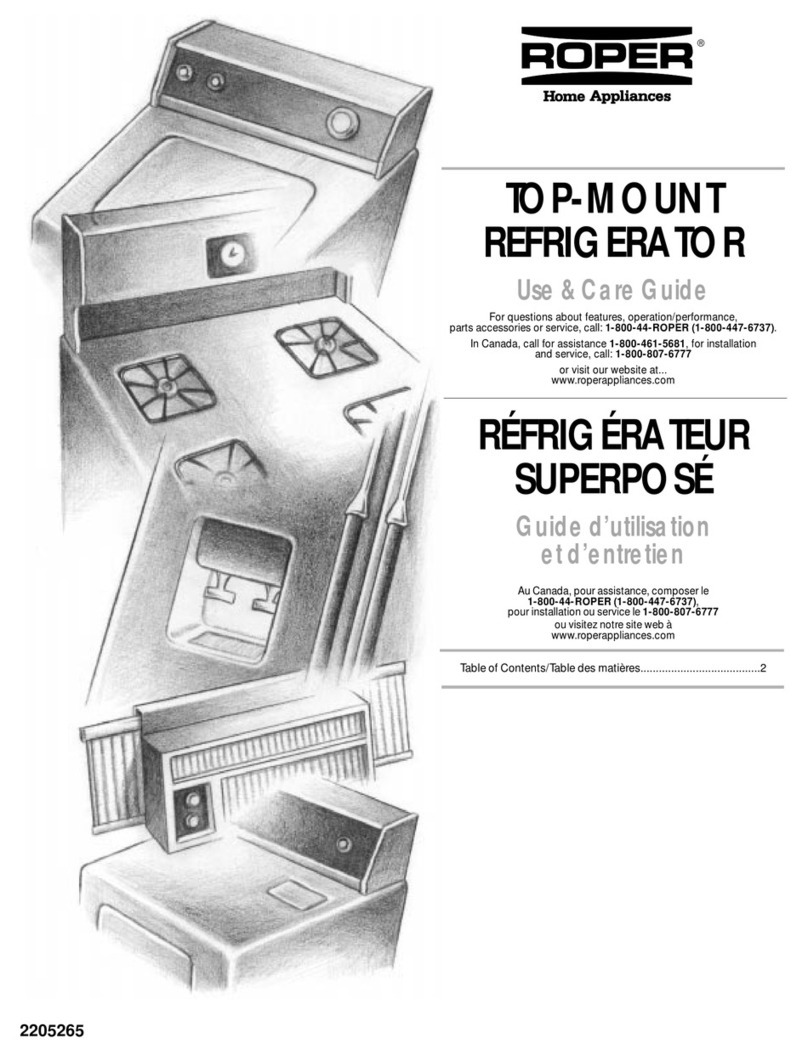
Roper
Roper Roper RT21LMXJW00 User manual
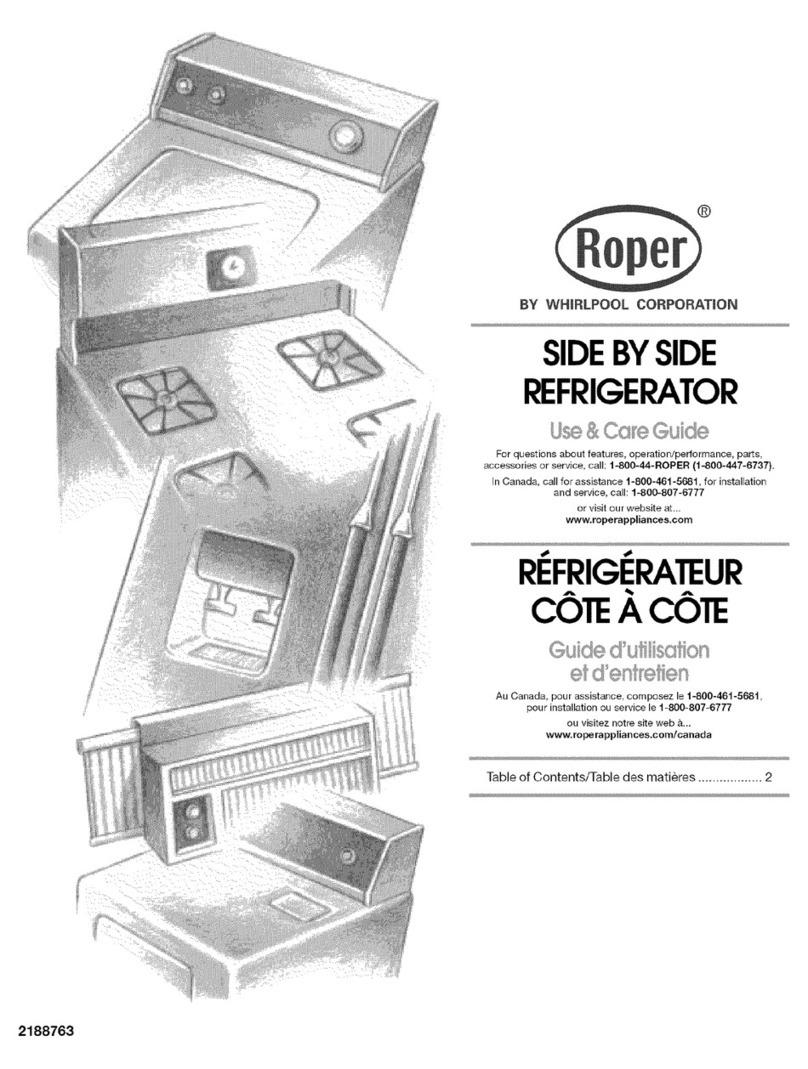
Roper
Roper RS25AFXRD01 User manual

Roper
Roper RT18DK User manual
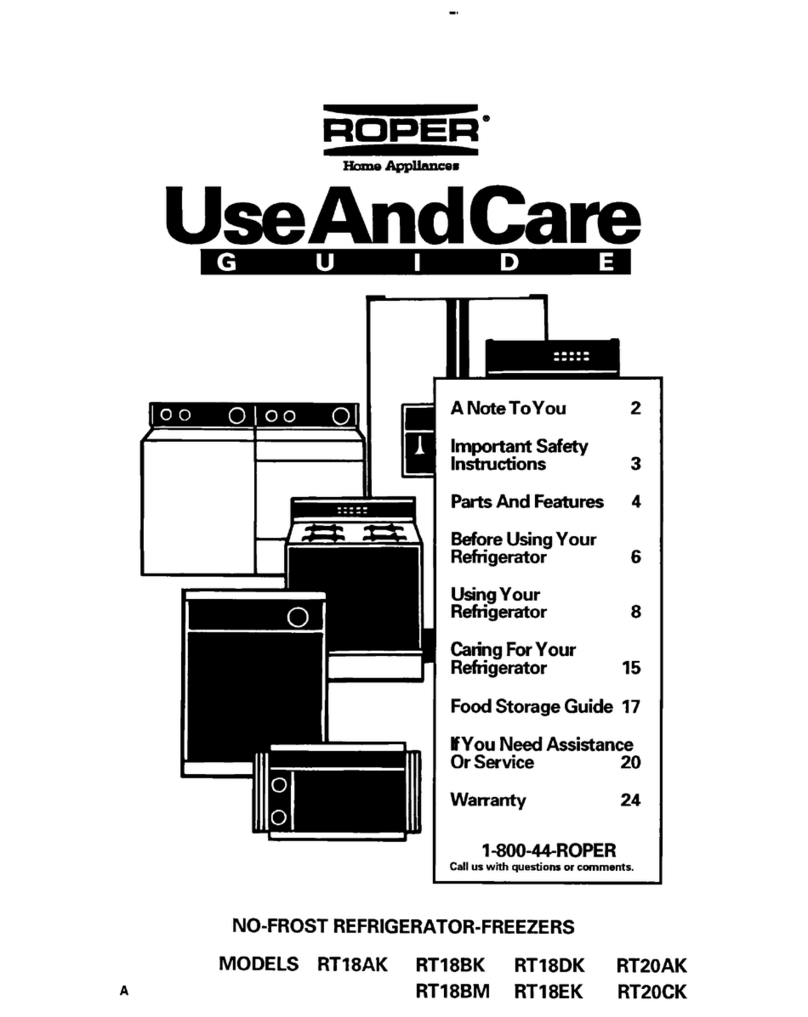
Roper
Roper RT18BM User manual
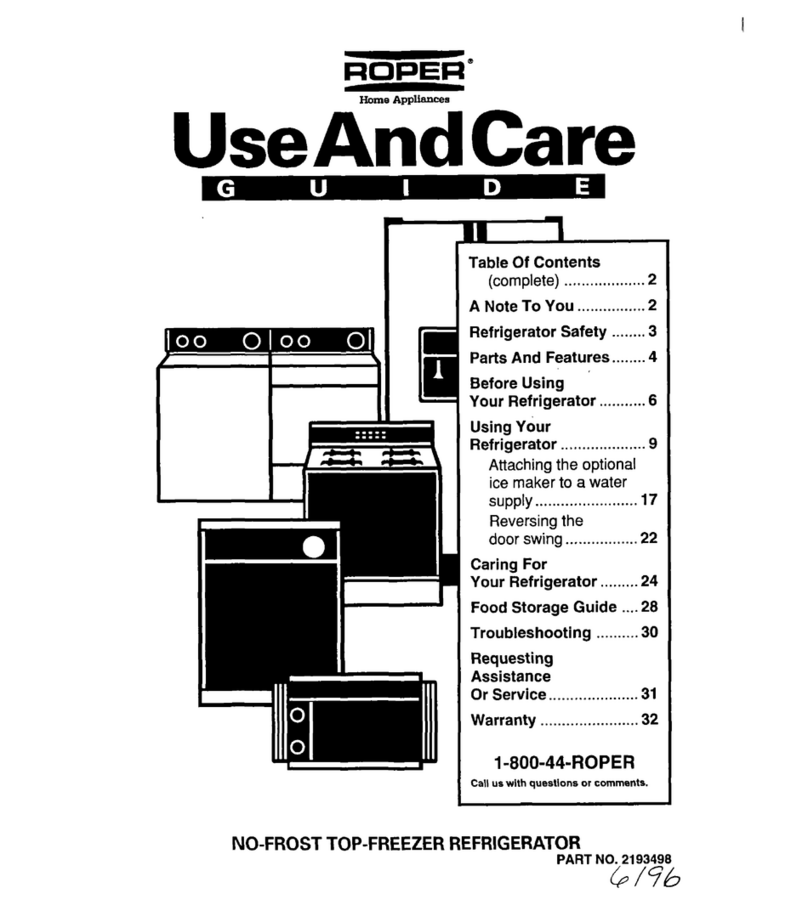
Roper
Roper Roper RT16DKXDN03 User manual

Roper
Roper RT16VK User manual

Roper
Roper RT14BKXSQ User instructions

Roper
Roper RT14DKXSQ01 User manual
